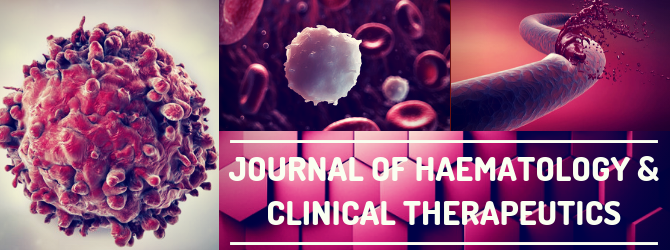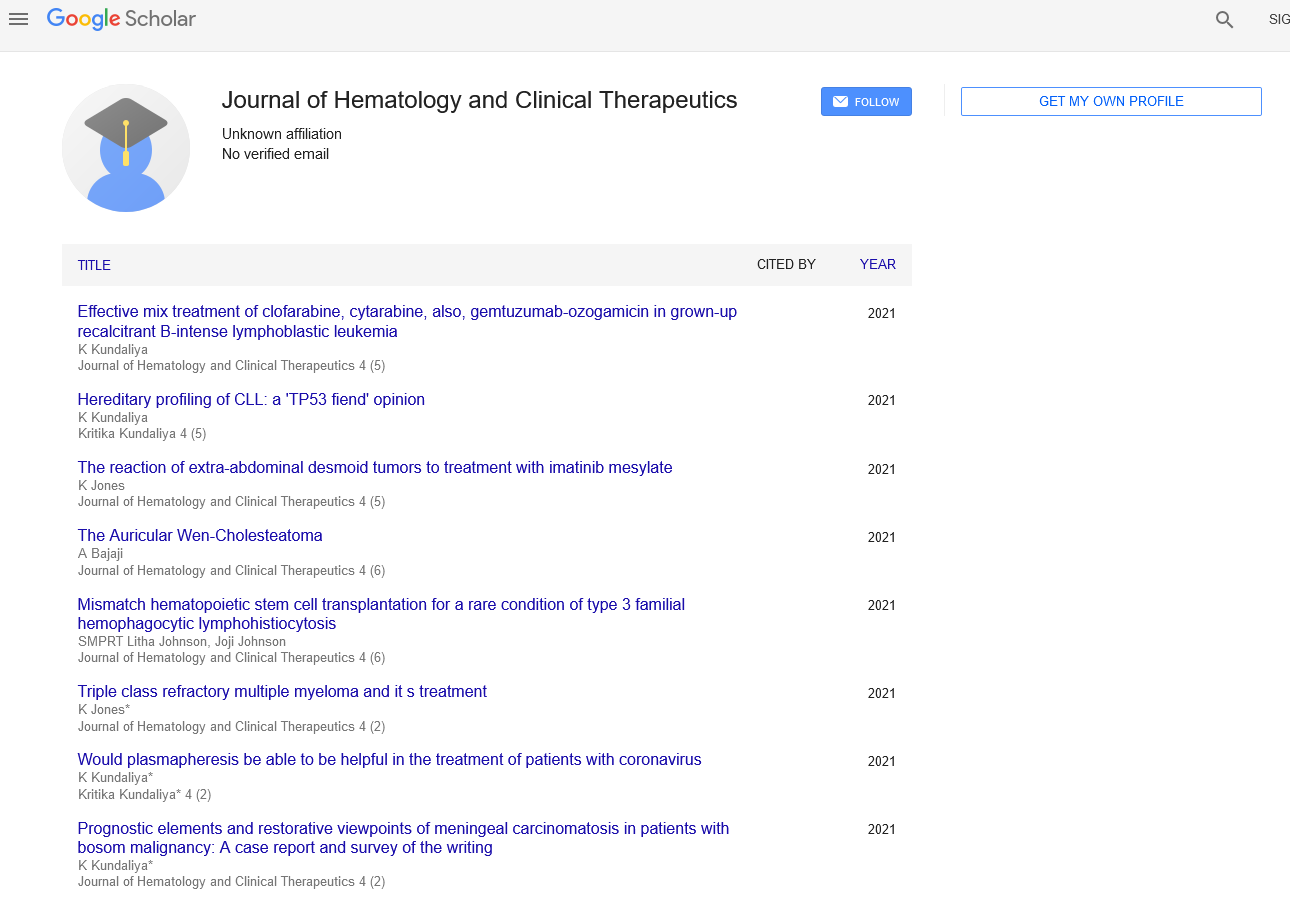Metchnikoff's inheritance: The dysplastic idea of natural insusceptibility in myelodysplastic conditions
Received: 08-Feb-2022, Manuscript No. PULJHCT-22-4631; Editor assigned: 11-Feb-2022, Pre QC No. PULJHCT-22-4631; Accepted Date: Feb 08, 2022; Reviewed: 15-Feb-2022 QC No. PULJHCT-22-4631; Revised: 20-Feb-2022, Manuscript No. PULJHCT-22-4631; Published: 21-Feb-2022
Citation: Jones M. Metchnikoff's inheritance: the dysplastic idea of natural insusceptibility in myelodysplastic conditions. J Haem Clin. 2022; 6(1):6-7.
This open-access article is distributed under the terms of the Creative Commons Attribution Non-Commercial License (CC BY-NC) (http://creativecommons.org/licenses/by-nc/4.0/), which permits reuse, distribution and reproduction of the article, provided that the original work is properly cited and the reuse is restricted to noncommercial purposes. For commercial reuse, contact reprints@pulsus.com
Introduction
More than a century prior, Metchnikoff's ocean side examinations concerning an eukaryotic living being's reaction to instigated irr-tation prompted the start of how we might we might interpret the natural resistant system. The lopsidedness of the lymphoid/ macrophage parts of this framework in myelodsyplastic conditions (MDS) produces an antagonistic immunological mileau for the improvement of immune system problems in this range of illnesses. Given the inborn commitment of myeloid and lymphoid cells to intrinsic invulnerability, it isn't surprising that the dysregulation of these cells affects ongoing myeloid clonal blood issues, especially MDS. The cytopenias and potential for movement of these issues are produced prevalently by their immunological anomalies, incendiary bone marrow microenvironment, hematopoietic immature
Various epidemiological and clinical examinations have exhibited an expanded frequency (10-30%) of immune system and provocative problems in relationship with MDS, going from restricted hematologic indications, for example, immune system hemolytic sickliness and insusceptible thrombocytopenic purpura, to foundational sicknesses influencing different organs, including vasculitis, connective tissue infections, incendiary joint inflammation and neutrophilic diseases. Some of these issues might be related with unfavorable results (e.g., vasculitis) or movement of the MDS. On the other hand, patients with immune system issues are bound to foster MDS than are individuals from the general population.6
Studies assessing the disturbed natural cycles including inborn invulnerability which underlie the lattice of these neoplastic and immune system/fiery infections have given significant experiences into the pathogenesis of their co-occurence. Administrative T cells (Treg) assume a basic part in controlling aggravation and immune system disorders and are available at a high recurrence in the bone marrow.
In lowerrisk MDS, the quantity of Treg was demonstrated to be diminished, consequently conceivably allowing the development of immune system reactions, including those coordinated against the dysplastic clone. Furthermore, it was independently exhibited that there are interleukin (IL)- 17 delivering T cells and raised serum levels of the supportive of fiery cytokines IL-7, IL-12, RANTES and interferon-γ in lower-risk MDS. In ongoing myelomonocytic leukemia (CMML) and a few MDS patients, monocytes show a strikingly strange utilitarian lopsidedness, involved >90% traditional sort monocytes, which, upon microorganism feeling, produce elevated degrees of an expansive scope of cytokines, including granulocyte province animating component, IL-10, CCL2, IL-6 and S100 fiery proteins. The last proteins are created because of initiation of pyroptosis, an inflammasomemediated cycle of cell passing in myeloid clonal disorders. Increased responsiveness of neoplastic CMML hematopoietic forerunner cells to microenvironmental provocative cytokines, for example, granulocyte-macrophage settlement animating component, has likewise been illustrated.
The size of a phone populace is arranged by apoptosis, an arranged type of customized cell demise, which happens fluidly during various phases of a sickness direction. Nonetheless, in the clinical setting in which incendiary problems happen, pyroptosis created by enacted inflammasomes likewise contributes significantly to cell passing in MDS. Inflammasomes are a class of intracellular poly-protein buildings basically made out of a sensor, a connector protein and an effector. The nucleotiderestricting space (NOD) like receptor NLRP3, is a redoxdelicate cytosolic sensor that selects the ASC (apoptosis-related spot like protein containing a caspase-enlistment area) connector protein. NEK7, an individual from the NIMA-related kinase (NEK) family, is ensnared in the control of inflammasome effector work. Because of assorted pathogenic boosts that trigger a course of downstream responses, cluttered cell homeo-balance, including mitochondrial brokenness and cost receptor flagging through Receptive Oxygen Species (ROS) are signals that control NEK7- intervened NLRP3 inflammasome activation.
This collaboration thusly causes polymerization of ASC into enormous cytoplasmic totals alluded to as ASC spots, allowing docking and enactment of caspase-1, which produces mature IL-1β and IL-18 (interferon-γ instigating factor) proinflammatory cytokines that are emitted into the extracellular space as provocative effectors of pyroptosis.
In this issue of Haematologica, depict the presence in plasma of a marker (ASC spots) of pyroptotic cell passing produced by enactment of the inflammasome inside MDS bone marrow cells from patients treated with recombinant erythropoietin and lenalidomide. The creators utilized confocal and electron microscopy to picture and stream cytometry to measure these bits, which are delivered upon cytolysis and course in fringe blood for broadened periods due to their intrinsic protection from debasement. They give information recommending the possible utility of such estimations to characterize inflammasome actuation, distinguished by this pyroptotic biomarker (ASC spots) and propose that this component, alongside appraisal of serum erythropoietin levels, may address a technique to recognize lowerrisk MDS patients whose weakness could profit from treatment with lenalidomide and erythropoietin. These discoveries give a possibly valuable way to deal with clinical appraisal of aggravation. Notwithstanding, they require further affirmation, particularly with respect to their explicitness and awareness for MDS patients' responsiveness to treatment.
There is a hereditary reason for the fiery peculiarities adding to a portion of the clinical circumstances related with MDS. Both germline and physical changes have been related with myeloid-related provocative illnesses, including Schwachman-Diamond disorder, an autosomal latent acquired infection with bone marrow disappointment and fiery side effects, and the myeloid-confined Cryopyrin-Related Intermittent Condition (CAPS), an auto inflammatory illness connected with transformations in the NLRP3 gene. Polymoprhisms in this quality might assume a part in the variable incendiary clinical elements in MDS patients. TET2 and graft quality changes, normal in MDS, add to fiery quality articulation in macrophages and are related with cardiovascular incendiary comorbidities.
Intense leukemic change is more incessant in MDS patients with autoinflammatory highlights than in those without. As of late, a clinically serious autoinflammatory infection related with MDS and other myeloid problems named VEXAS condition (described by Vacuoles in myeloid antecedents, E1-ubiquitinating protein unusual capacity, X-connected, Auto inflammatory issues, and Somatic change) has been credited to a physical transformation in the UBA1 gene. This issue has gotten away from much earlier clinical consideration since the quality isn't caught by latest cutting edge sequencing transformation boards. Treatment of MDS patients wih disarranged immunological and fiery parts has been hazardous. For specific related infections, for example, CAPS and Schnitzler condition with NLRP3 actuation, IL-1 and IL-1 receptor bad guys have been useful in illness the executives and are presently being considered for MDS. Although a few MDS patients with both sickness components might answer treatment with hypomethylating specialists or to bad guys of IL-1 or IL-6 or their particular receptors, these medications seem to have just delaying impacts in this illness setting; by the by, they might be steroidsparing as a guide to side effect management. Other atomic targets have been assessed for the therapy of such patients, including hindrance of the Toll receptor or Bruton tyrosine kinase signaling. The more as of late found NEK7 part of NLRP3 initiation might give a clever objective to inhibitors of the inflammasome's upstream effector arm. what's more, given the significant job of Treg in controlling aggravation and of their lack in lower-risk MDS patients, thought of Treg utilization as an element of cell remedial methodologies for such patients might demonstrate important in this neoplastic illness with cluttered natural immunity.
Along these lines, envoys techniques to work on comprehension of pathogenic instruments fundamental basic communications among aggravation and myeloid neoplasia. Such advances ought to work with the improvement of more compelling ways to deal with the treatment of the dysplastic intrinsic invulnerability associated with the hemato-incendiary nature of MDS.





